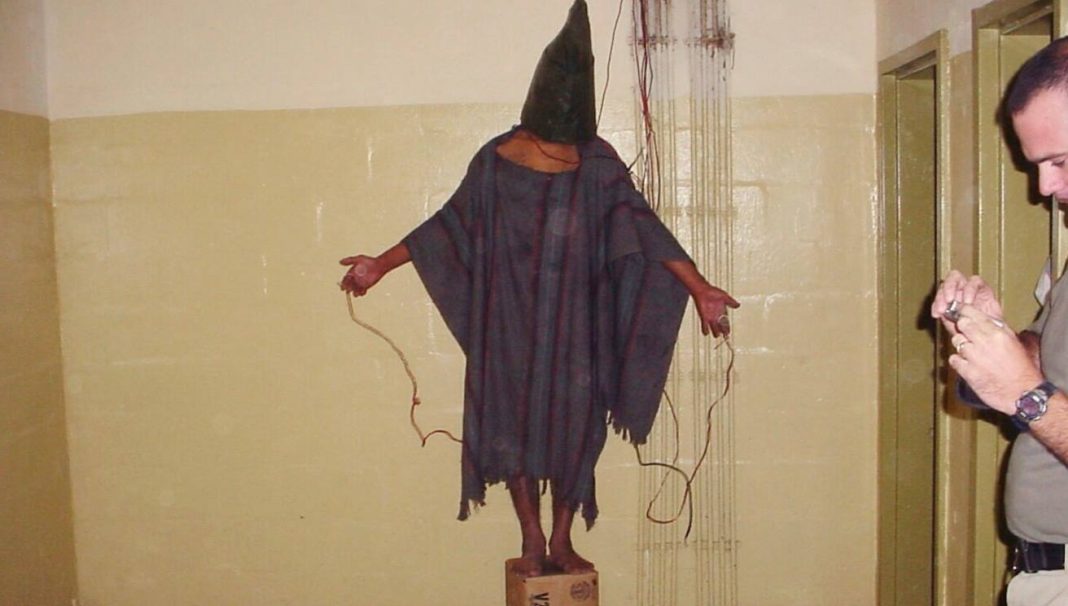The Abu Ghraib prison scandal, which shocked the world in 2004, revealed the brutalities committed by U.S. military personnel against detainees in Iraq. Graphic photographs surfaced, showing Iraqi prisoners subjected to inhumane treatment, including torture, sexual abuse, and psychological degradation. For years, the Bush administration attempted to downplay the scandal, calling the abuses isolated incidents, but the images and reports painted a different, far darker reality. Now, for the first time, a jury has held a U.S. military contractor, CACI, accountable for its involvement in the abuses at Abu Ghraib.
The Horror at Abu Ghraib
The atrocities committed at Abu Ghraib were not isolated or incidental but part of a systemic pattern of abuse carried out by the United States military in Iraq, Afghanistan, and Guantanamo Bay. Abu Ghraib, a notorious prison under Saddam Hussein, became a symbol of U.S. power and control after the invasion of Iraq in 2003. However, it quickly morphed into a site of horrific human rights violations. Many of the detainees were innocent civilians, swept up in random military sweeps or at checkpoints. The Red Cross reported that 70-90% of detainees at Abu Ghraib had no links to armed insurgents, further highlighting the injustice of their mistreatment.
In January 2004, military police officer Joseph Darby exposed the horrors unfolding at the prison after discovering photographs of detainees being sexually assaulted, beaten, and tortured. The most damning images showed U.S. soldiers humiliating prisoners in cruel and degrading positions, such as hooding them, placing them on leashes, and subjecting them to electric shocks. These images soon made their way to the public through CBS News, and the world was stunned by the extent of the abuse.
A Landmark Legal Decision
After years of legal battles, the first major legal victory has come for the victims of Abu Ghraib. A jury has ruled that CACI, a private defense contractor, must pay $42 million in damages to three Iraqi detainees who suffered torture at the hands of the U.S. military. These three men, although not seen in the infamous photographs, testified in court about their harrowing experiences. Zah El Aali, an Al Jazeera journalist, Assad Azua, a grocery store owner, and Suel Al Shamari, a middle school principal, each recounted being beaten, shocked with electric prods, subjected to forced nudity, threatened with dogs, and sexually assaulted. One detainee was even dragged by a rope around his neck through the prison.
CACI’s defense was to question whether these specific detainees had truly suffered the abuses they claimed. The company tried to distance itself from the responsibility, asserting that its employees did not contribute to the torture. However, the jury disagreed, finding CACI’s interpreter complicit in the mistreatment of the detainees. This ruling not only brings some form of justice to the victims but could set a significant legal precedent for other private contractors involved in human rights abuses.
Implications
This ruling against CACI could have far-reaching consequences, as it sends a clear message to corporations that profit from war: they cannot escape responsibility for the actions of their employees, especially when those actions violate basic human rights. The ruling could deter other companies from engaging in military contracting, where the lines between legitimate business and involvement in war crimes are often blurred. This case reinforces the idea that corporations, especially those in conflict zones, must ensure that they thoroughly vet, train, and supervise their employees, and hold them accountable for their actions.
Read More: Iran Introduces “Hijab Removal Treatment Clinic” for Women Defying Hijab Laws
The ruling may also encourage further legal actions against contractors involved in the torture and mistreatment of detainees, both in Iraq and elsewhere. The lawyer representing the victims believes that this judgment could open the door for more cases, further challenging the impunity with which military contractors have operated in conflict zones.
The Political Fallout
The Abu Ghraib scandal was a major blow to the George W. Bush administration, damaging its credibility and undermining its claim that the U.S. invasion of Iraq was about spreading democracy. Instead, it exposed the dark side of the war on terror, where torture and human rights violations became part of U.S. military strategy. The images of American soldiers abusing Iraqi detainees were not just a violation of international law but also a betrayal of American values, according to the Bush administration’s own public statements at the time.
The Bush administration attempted to downplay the scandal, with officials insisting that the actions of the few soldiers involved did not reflect U.S. policy. However, investigations, including a Senate report, confirmed that the use of torture was not only authorized but was part of a broader system of abuse at U.S. detention centers. Documents like the “Torture Memos,” prepared by the U.S. Department of Justice, outlined how the Bush administration authorized the use of enhanced interrogation techniques, which are widely regarded as torture, on foreign detainees.
In the aftermath of Abu Ghraib, 11 soldiers were court-martialed, but higher-ranking officials, including those who authorized the practices, faced no legal consequences. The scandal revealed the U.S.’s disregard for the Geneva Conventions and human rights norms, a shameful legacy of the war on terror.
The legal victory for the detainees at Abu Ghraib is a small but significant step toward justice for the victims of U.S. military abuses. The $42 million judgment against CACI serves as a reminder that private contractors cannot evade responsibility for their actions, especially when they are complicit in war crimes. However, it also underscores the broader moral and legal failings of the U.S. government’s conduct in Iraq, which continues to tarnish its reputation on the global stage. The abuses at Abu Ghraib were not isolated incidents, but part of a much larger system of torture and inhumanity that has yet to be fully addressed. While this judgment offers some measure of justice, the wounds inflicted on the Iraqi people, both physical and psychological, remain deep and unresolved.














